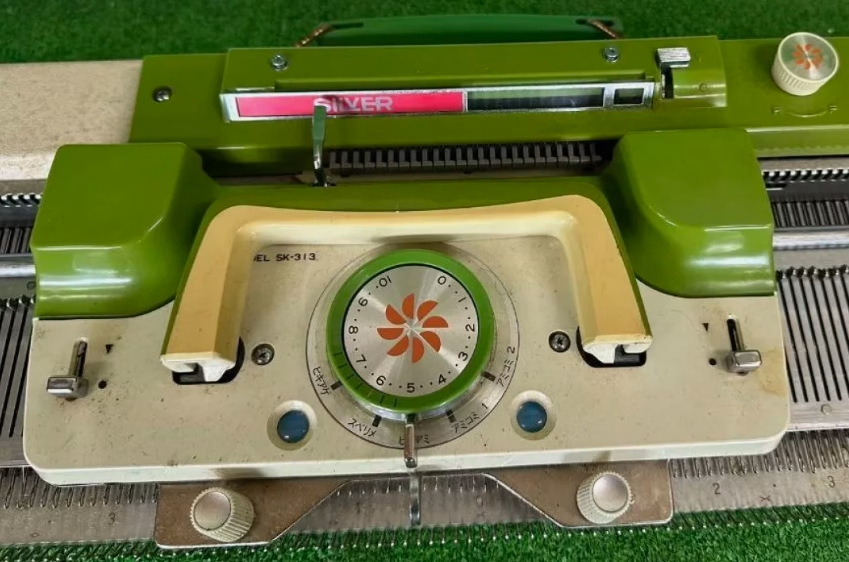Silver SK313 knitting machine appeared on the market in 1970. It is a standard-gauge knitting machine with 200 needles, 4.5 mm apart.

This machine has punch-card reading capabilities to automatically select needles and create patterned knitted fabric.
Unlikes most Silver/Silver Reed/Singer/Studio knitting machines with patterning drums, Silver SK313 does NOT have rubber end-rails but metal ones instead. This is a HUGE advantage since rubber rail ends crumble often and need to be replaced. However, they are truly needed if you are knitting on the full bed. But even with enough precuations (like do not extend the carriage pass the needle bed so the drums are ALWAYS on the needlebed and nos suspended), a knitter can get away without those as well.

Except for its greenish color scheme, Silver SK313 is similar to its earlier counterparts, Silver SK311 and Silver SK312.

All these machines have an interesting feature: when you knit for a while, and the pattern on the card is finished, a STOP word will appear on the display of the punchcard reader. This STOP word is actually from the punch card itself. Thus, punchcards for this machine are very easy to distinguish by this giant STOP lettering.

Then you will have to rewind the card to the starting position. The manual describes this feature well. I am not sure if this is the feature of the cards themselves or of the reader. I am yet to work on one of those machines. Later knitting machines allow a constant reading of the card: the card is simply clipped and is ready circular over and over.

However, a very distinct feature of Silver SK313 is its buzzer, which sits on top of the punch card reader. The green bar in the picture below shows this buzzer. I am still looking for a better picture of this buzzer.


The buzzer uses batteries to make sound. Sometimes, due to the presence of these batteries, some list these machines as electronic, which they are not. The buzzer might also sit to the side, similar to how it can be positioned on the Silver SK315 model (judging by the same protruding screws located at the same distance from each other as the screws on top of the punchcard reader).

Note that this model still has only one lever on the pattern panel: only to release the punchcard so it advances when the machine knits patterns and is passed back and forth. Later models have two levers: one for card release and one to expand the pattern vertically by a factor of two.
The machine can have a two-color fair isle knitted simultaneously (the manual calls it “knit-in”). However, only the main yarn is threaded through the yarn feeder. The second yarn (the contrasting one) is hooked on the yarn holder. I’ve seen a similar 2-color knitting technique on the vintage (pushbutton and first punchcard) Brother machines. On Silver SK311, you will also need knit-in brushes. This technique is a bit similar to weaving (although positions for the weaving and knit-in brushes are different). Both techniques are described in the manual pretty well.


Another interesting feature of Silver SK313 (which can be also found in Silver SK312 but not in later punchcard machines manufactured by Silver/Silver Reed) is the blue and red indicators (in the picture below both of them are red) of the Russel lever position.

Other than that, this machine is similar to its earlier counterparts, Silver Sk311 and Silver 312: all have the same accessories, a stand-alone tools box with a lid, and major parts (sinker plate and a tension mast) stored in the lid.



